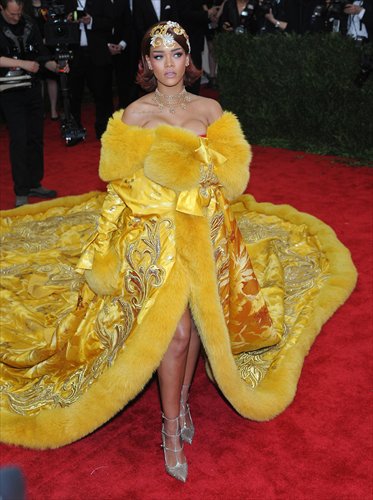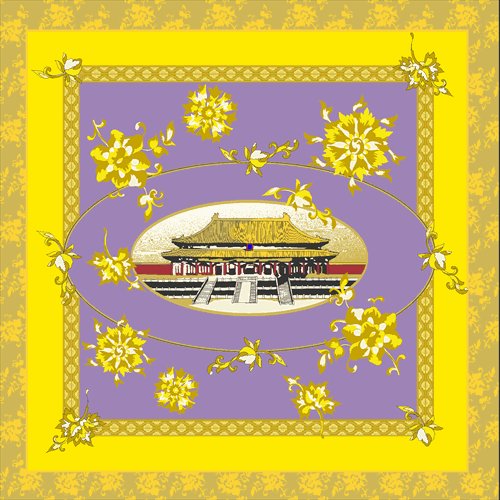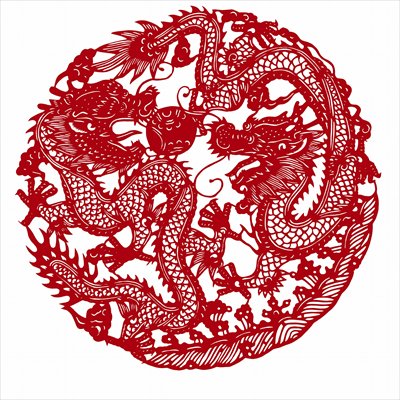Monkey designs by international brands trigger heated fashion discussions

American singer Rihanna, wearing a gown by Chinese designer Guo Pei, enters the "China: Through The Looking Glass" Costume Institute Benefit Gala at the Metropolitan Museum of Art in New York on May 4, 2015. Photo: IC
A post about international brands launching special designs for the coming Chinese lunar new year, the Year of the Monkey, has sparked heated discussions on Chinese social media.
"It seems as if foreigners think if they simply design a monkey, Chinese people would like them," said Zhong Ying.
Zhong, 24, is among the many Net users following the post. As a member of the Beijing Hanfu Association, she has been advocating for the hanfu (clothes of the Han people) culture for years and pays a lot of attention to modern designs with Chinese elements.
She said, at first glance, she thought the designs pictured in the post were "so ugly that they make people want to cry."
The post shows various products, including a Jaquet Droz wristwatch with a monkey design, a Louis Vuitton bracelet and a Dior necklace with monkey-shaped pendants, and an Armani limited edition foundation makeup case with the Chinese character "fu (happiness)" printed on it and a monkey imprinted on the powder inside.
Originally released on Sina Weibo on January 10, the post has been reposted almost 40,000 times and received 17,000 comments up to Monday, with most Chinese Net users saying the designs are "too ugly." A series of articles and posts with similar comments have also been circulating.
This is not the first time that the topic of "Chinese style" has made the news recently. The 2015 Met Ball also triggered great discussion on the issue. The Costume Institute Gala at Metropolitan Museum of Art, also known as the Met Ball, in New York on May 4, 2015, was China-themed with celebrities showing up at the event dressed to the theme. Some of the designs in the show received negative comments on their use of Chinese elements.
It is no secret that international brands are making more effort to appeal to Chinese consumers whose purchasing power have been growing rapidly in recent years. However, whether those attempts hit the sweet spot for Chinese consumers or show a misunderstanding of the Chinese culture is constantly under discussion.

A scarf featuring the Taihe Palace from the scarf series designed for the Palace Museum by Caroline Xue and her team. Photo: Courtesy of MARJA KURKI Fashion
Borrowing from the traditional
"Those monkeys resemble real monkeys too much," Zhong said. "I would prefer them shaped like the Monkey King (a fictional hero originally from the Chinese classic, Journey to the West)."
She said the Monkey King is more appreciated by the Chinese compared with ordinary monkeys because most Chinese worship Monkey King since childhood.
Another example is a series of recently released shoe designs by Nike where red Chinese characters are printed on the shoes. One pair says fa, meaning fortune, and another says fu (happiness), but Chinese Net users jestingly combined the two and said the shoes are "cursing" people to "fafu," which means to become fat.
Zhong commented on the Nike shoes, saying that the over-simplified way of printing red characters on shoes make them "look like they are from the 1970s or 1980s."
"In general, I think the aesthetic principle that foreigners have is simpler and more direct, but Chinese would prefer things that are beautified," Zhong said.
For example, born in the Year of the Goat, Zhong bought a gold sheep-shaped necklace last year. However, instead of resembling a real sheep, the fat sheep on her necklace is stylized.
When it comes to personal taste, Zhong prefers clothing and jewelry that borrow elements of Chinese clothing styles from ancient or pre-modern times, instead of simply printing or engraving some patterns. But she is disappointed to see that there is a lack of such designs.
"After all these years, most designers who use Chinese elements are only using pankou (buttons made of thread)," she said. "With thousands of years of history in clothing design, there are so many features one can borrow from in traditional Chinese clothing. There are so many kinds of fabrics. There are many ways to cut a skirt. And even for a simple chanzhilian pattern (a traditional pattern with lotuses and wavy branches), there are numerous variations."


Designers work to find the best way of using Chinese style in fashion. Photos: IC
Finding the balance
Caroline Xue, managing director of MARJA KURKI Fashion (Beijing) Co. Ltd, which specializes in customized scarf design, explained that one of the reasons many Net users make fun of these "Chinese-style" designs is that they might consider them "too cartoonish and too childish" for brands targeting mature consumers.
"It shouldn't be a simple work of stacking, listing, or accumulating," Xue said, adding that the key to good Chinese-style designs lies in finding the balance.
She led a design team in creating gift scarves for the Palace Museum in 2008. The scarves were to cater to both domestic and foreign customers, so the assignment, which required that the designs show the museum's characteristics and be beautiful to wear, was not easy, Xue said.
"When one is required to present Chinese elements, it's especially delicate for the designer to know the balance," she said. "The principle is not to overly please the consumers."
She said that a designer must take several things into consideration and that using Chinese elements alone is not enough.
In the first stage, the team collected a lot of elements and images for inspiration, Xue said. "[But] we didn't just plainly put elements on the scarves, which will be like a lame advertisement."
Aside from color combinations and how their designs will look against the skin, Xue said some amount of weight must be given to the meaning and purpose behind what is being designed.
She said her team had heated discussions about what to do for the upcoming Year of the Monkey.
"The idea of using a monkey on the scarves was rejected by every Chinese member of the team, and they said it might end up in having stocks that will not sell for years," she said. "Monkeys are not as lucky in Chinese culture. They are naughty and not as desirable as horses or dragons."
Xue suggested international brands listen more to their local Chinese teams who better know local consumers' psychology. "[Foreigners] might overexert themselves," she said. "[They] might use beautiful things but they can't just assume Chinese people love the most traditional things. Nobody is wearing a qipao (cheongsam) or magua (mandarin jacket worn over a gown)."
A clever way would be combining the modern and the traditional, the Western and the Chinese, said Xue. "There must be alteration. I think [the international brands] know all about it, but their problem is that they are so eager to cater to the Chinese market that they forget to properly listen to the local team."
A foreigner's point of view
Nels Frye, former editor-in-chief of the Beijing-based Lifestyle Magazine, and head of stylites.net, a fashion platform for creative consultancy, told Metropolitan that he notices a lot of foreign brands are doing "the Chinese New Year gimmick."
"It seems like they (the designs that Net users make fun of) are a little bit too cartoonish, with the monkeys that are slightly grotesque," he said. "It might get a little bit tiresome for people, but it is still an okay sales & marketing strategy."
On some level, the brands want to show they are friendly to Chinese customers, and sensitive to their traditions, he said. However, Chinese style in fashion is far more than using Chinese zodiac signs in special edition designs.
"I think the brands that I like are a little more understated in what they think is Chinese. But most importantly, they are more innovative in materials and cuts that are new but also clearly have traditional inspiration," Frye said.
With years of experience working with both foreign and Chinese designers, Frye has found a lot of good designers of Chinese styles in Beijing.
They include BIFU by Xing Chen, a design brand based in Qianmen area, Dongcheng district, and Rechenberg, founded based on German-born designer Kathrin von Rechenberg's signature fabric "tea-silk" that dates back to the Ming Dynasty (1368-1644).
Compared to the more obvious Chinese elements, Frye prefers things that are more subtle, brands that use Chinese cultural "influences" rather than colors or patterns. Although Frye thinks foreigners might tend to like more obvious elements, such as dragons and cheongsam, he rejects the idea of categorizing the differences between Chinese and foreigners based on how they appreciate and interpret the Chinese style. For him, the differences usually go back to different levels of sophistication and whether they have international outlooks.
He gave the fashion brand NE-Tiger and designer Guo Pei as examples, and said both are "extremely in-your-face and overwhelming Chinese style" but are very successful and popular among Chinese customers. "Both foreigners and Chinese have created brands that are perhaps a little bit more attractive, subtle, and nuanced, in their way of interpreting Chinese style," he said.
Newspaper headline: Zhongguo-style